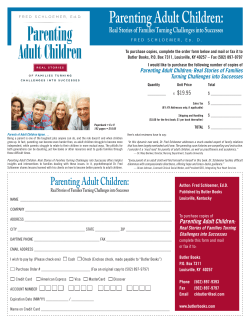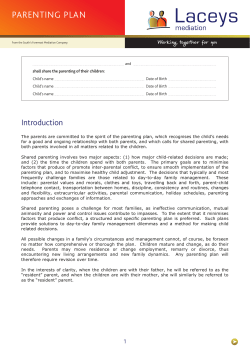
Change in Parenting Self-Efficacy after Cog
Neurocognitive Rehab Lab School of OT Faculty of Medicine Hadassah and Hebrew University What is Parenting Self-Efficacy? Change in Parenting SelfEfficacy after CognitiveFunctional (Cog-Fun) treatment in OT for children with ADHD Jeri Hahn-Markowitz, Dana Zeides Taubin, Adina Maeir Neurocognitive Rehabilitation Laboratory School of Occupational Therapy, Hebrew University in Jerusalem Background Subjective belief in ability to enlist motivation, cognitive resources and skills necessary to successfully encourage & nurture child. High PSE = high involvement, satisfaction & enjoyment from parental role; security in ability to acquire & use parenting strategies that increase the probability that their children will display high social, emotional and academic abilities. Low PSE = experience difficulty in parenting skills in challenging situations and may avoid coping with them. (Bandura, 1995; Jones & Prinz, 2005). What is Cog-Fun? Literature on parents of children with ADHD shows that their PSE is low Cognitive-Functional treatment aims to promote: (Finzi-Dottan, et al, 2011; Whalen, et al, 2011; van den Hoofdakker et al, 2010; Jones & Prinz, 2005). • Executive Functions Can this be changed by participation in Cog-Fun treatment in OT? • Child and parent self-efficacy • Quality of life (QOL) among children with ADHD and their families (Maeir, et al., 2014a; Maeir, et al., 2014b; Hahn-Markowitz, et al., 2011). Cog-Fun change agents: based on OT models • Child and family-centered occupation-based intervention • Enabling therapeutic relationship (Intentional Relationship Model, Taylor, 2008) • Identify, strengthen & connect occupations to child’s volition (MOHO, Kielhofner, 2008) • Executive strategy acquisition and self awareness (MCT, Toglia, 2011) Methods: Tools • Tool to Measure Parenting Self-Efficacy (TOPSE) (Kendall & Bloomfield, 2005) • Behavioral Rating Inventory of Executive Functions (BRIEF) (Gioia, et al, 2000) • Pediatric Quality of Life 4.0 Generic Cores Scales (PedsQL) (Varni, Seid & Kurtin, 2001) • Canadian Occupational Performance Measure (COPM) (Law, et al, 2005) • Environmental supports and functional training (Neurofunctional approach to Cog Rehab, Giles, 2011) 1 Neurocognitive Rehab Lab School of OT Faculty of Medicine Hadassah and Hebrew University RCT – Cog-Fun Effectiveness (N=99) Methods: Study Population • Children (7-10 y.o., in 2nd-4th grade at first assessment) diagnosed with ADHD, referred by MDs • Regular schools • No serious neurological or psychiatric co-morbidities RCT – Crossover Study (3 mo. between assessments) Time1 Research Pre-tx Group Assess Control Group Assess1 Intervent’ Time2 Crossover Time3 Cog-Fun Post-tx Assess No tx Followup Wait period Pre-tx Assess Cog-Fun Post-tx Assess Tool to Measure Parenting SelfEfficacy (TOPSE) (Kendall & Bloomfield, 2005) 8 Scales (6 items per scale) • • • • • • • • Emotion and affection Play and enjoyment Empathy and understanding Control Discipline and limit-setting Pressures Self-acceptance Learning and knowledge RCT – Cog-Fun Effectiveness (N=99) Study Population Blocked Randomization Research gr Control gr Boys 7-8 24 26 Girls 7-8 11 7 Boys 9-10 9 10 Girls 9-10 6 6 Total 50 49 Tool to Measure Parenting SelfEfficacy (TOPSE) (Kendall & Bloomfield, 2005) • 48 items (Likert rating 0 -10) • 8 scales • Lower scores reflect lower PSE. • High internal reliability on each scale (0.80-0.89) and for all items (Cronbach’s alpha=0.94) Tool to Measure Parenting SelfEfficacy (TOPSE) (Kendall & Bloomfield, 2005) Examples of scale statements: “I am able to show affection towards my child.” “I am able to have fun with my child.” “I am able to explain things patiently to my child.” “As a parent I feel I am in control.” “Setting limits and boundaries is easy for me.” “I do not feel a need to compare myself to other parents.” “I know I am a good enough parent.” “I am able to recognize developmental changes in my child.” 2 Neurocognitive Rehab Lab School of OT Faculty of Medicine Hadassah and Hebrew University TOPSE Data analysis RCT – Cog-Fun Effectiveness (N=99) Hypotheses • MANOVA repeated measures by group to examine the interaction effect (Time X Group)on TOPSE scales. • MANOVA repeated measure to examine improvement in TOPSE scales after Cog-Fun tx. 1. A time effect will be found on the Tool to Measure Parenting Self-Efficacy (TOPSE) after Cog-Fun tx. 2. An interaction effect will be found between the research and control (waitlist) groups on the TOPSE. 3. Significant correlations will be found between PSE, EF, QOL and occupational performance. Interaction Effect: Group (Research vs Control) by Time (time1, Time2) on TOPSE total scores Treatment effect in both groups (pre-post treatment) Topse Scales: Discipline* Play* Control* Empathy* Time effect F= 8.43; p=.005 Group *Time F= 5.612; p=.02 TOPSE correlations with other measures after treatment (N=88) TOPSE/ BRIEF/ COPM/ QOL Emotional Control Inhibit QOL COPM Play Control TOPSE Scales: Discipline* Play* Control* Empathy* Discipline Empathy -.248* -.258* -.251* -.111 -.130 -.230* -.240* -.290** .450** .372** .380** .440** NS .221* NS NS Results • Significant improvements in parenting self-efficacy after tx and a significant interaction effect were found between group and time. • Correlations with measures of EF, QOL and occupational performance • Supporting evidence for the effectiveness of Cog-Fun tx for improving self-efficacy among parents of children with ADHD * <.05; **<.01 3 Neurocognitive Rehab Lab School of OT Faculty of Medicine Hadassah and Hebrew University Cog-Fun change agents Ramifications • Child and family-centered occupation-based intervention Improved parenting self-efficacy of • Enabling therapeutic relationship parents who participate in Cog-Fun tx (Intentional Relationship Model, Taylor, 2008) • Identify, strengthen & connect occupations to child’s volition (MOHO, Kielhofner, 2008) • Executive strategy acquisition and self awareness (MCT, Toglia, 2011) with their child can help them to continue helping their child after therapy is finished. • Environmental supports and functional training (Neurofunctional approach to Cog Rehab, Giles, 2011) Limitations • Longer treatment periods and/or more support for parents after CogFun would increase the tx effect. • Future studies should include a longer follow-up period. Cog-Fun References Maeir A, Hahn-Markowitz J, Fisher O, & Traub Bar-Ilan R. (2014). Cognitive Functional (Cog-Fun) intervention for children with ADHD: Theory and practice. In I Berger & A Maeir (Eds.), ADHD - A transparent impairment, clinical, dailylife and research aspects in diverse populations. New York: Nova Science Publishers. Maeir A, Fisher O, Traub Bar-Ilan R, Boas N, Berger I, & Landau YE. (2014). Effectiveness of Cognitive-Functional (Cog-Fun) Occupational Therapy Intervention for Young Children with Attention Deficit Hyperactivity Disorder: A Controlled Study. AJOT, 68(3): 260-267. Hahn-Markowitz J, Manor I, & Maeir A. (2011). Effectiveness of Cognitive-Functional (Cog-Fun) Intervention with Children with Attention Deficit Hyperactivity Disorder. AJOT 65(4): 384-392. Thank you! jerihahnmarkowitz@gmail.com 4
© Copyright 2025










